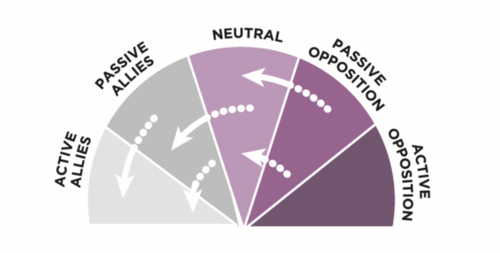Spectrum of allies
Spectrum of allies describes a concept that examines the potential opposition and support of people and groups, ranging from those who are most dedicated opponents to the most active supporters; helpful tool for deciding what tactics to employ based on a team’s relation to specific allies. - 350.org, adapted by Michelle Xie [1]
This tool is helpful in identifying the social groups (students, workers) that are affected by your issue, and to locate those groups along a spectrum, so you can focus your efforts on shifting those groups closer to your position. The tool also encourages looking at society as a collection of specific communities, some of which can be defined as institutions (unions, churches, schools), others of which are less visible such as youth subcultures or demographic groups. Identify impacted communities can help you develop a more targeted strategy that moves groups closer to your position.

Source: George Lakey, Training for Change
How to use the spectrum of allies
|
Disposability discourse |
Much discussion around the severity of COVID was lessened by expressing how it mainly sickens and kills elderly, chronically ill, and disabled people. This discourse suggests these groups are seen disposable. |
|
Loosened restrictions too early |
When governments loosened COVID restrictions in response to business demands, political pressure, and public impatience, rather than scientific evidence, high risk populations (the chronically ill, disabled and elderly) were subsequently told they are disposable yet again. |
|
Working through illness |
Regulations around how many sick days should be required when someone falls ill with COVID also demonstrated ableism. In relation to these regulations, and in favour of profit above health, many politicians including US President Joe Biden, praised themselves for working through COVID, instead of encouraging people to rest and recover if they'd fallen ill. |
|
Individualism |
Individuals have been encouraged to make 'personal' choices on vaccines (without legitimate health restrictions), masks and gatherings. "There is no individual safety without collective safety and collective safety requires that no one is safe unless everyone is safe." - Mia Mingus [2] |
If you have any suggested revisions or additional resources to share related to the above content, please email them to kenzie@lehub.ca.
